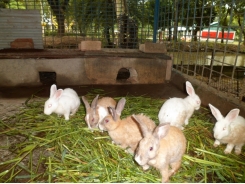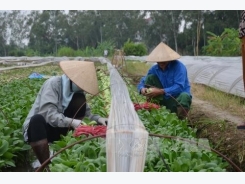Engineer develops drones for farmers

Lightweight: An A16 drone weighs only 22kg. Each costs from VNĐ165 million (US$7,200) to 368 million ($16,200) depending on the amount of pesticide that it can carry.
About 1,700ha of custard apples are growing in Lục Nam District in the northern province of Bắc Giang. After Tết (Lunar New Year festival), growers will have to spray pesticides by hand to prevent spider mites from damaging the crop.
“Not many pests bother custard apples, so we just need to spray once, yet we are still concerned about its effect on health as sprayers are directly exposed to the pesticide,” said Bùi Văn Quang from Lục Nam District.
For other agricultural produce, including rice, oranges and lychees, farmers need to spray regularly to get rid of pests.
According to the General Department of Preventive Medicine in Việt Nam, pesticide inhalation kills more than 300 farmers in Việt Nam each year and seriously affects another 5,000.
To prevent poisoning and reduce work, mechanical engineer Lê Phi Cường and his team have developed a flying drone that can accurately spray crops.
The device, named A16, carries a 10-litre pesticide tank that can cover one hectare at a time. It takes more than half an hour for an A16 to finish the work. This is about 30 times faster than through manual spraying.
Drones can be used on slopes growing plants up to 20m that are not suitable for manual spraying. Farmers can operate the drone via a mobile phone with an application interface. The faster coverage is especially useful in controling insects and diseases in time.
An A16 drone weighs only 22kg. Each costs from VNĐ165 million (US$7,200) to VNĐ368 million ($16,200) depending on the amount of pesticide that it can carry.
“We aim for cheap, easy-to-use and easy-to-maintain techniques in Việt Nam,” said Cường.

Each to his own: Every member is in charge of a different task, from automation, software, design and pumps for the drones.

All terrain: The drones will help prevent poisoning, reduce farm work - and reduce pesticide wastage. Photos courtesy of Lê Phi Cường
The A16 is equipped with six to eight propellors to make sure it can return home if problems arise. If the drone encounters an obstacle, the sensor will make it stop about three to five metres in front of it. The drone can also maintain a particular height despite the field surface - on flat land or mountain terraces.
Cường had an early interest in aviation and airplanes. When he was small, his family lived near Hà Nội Children’s Palace, where children could join a range of culture and arts activities and classes.
“Every time I visited the palace, I would see various aeroplane models. I loved them. The special interest in aviation devices lingered in my mind as I grew up,” Cường added.
This passion led him to the Aviation Club in the city, a platform where members share not only their hobbies, but also knowledge about planes, drones and aviation.
“Joining the club, I had chance to meet people who shared my passion. We taught ourselves and shared the knowledge with each other,” said Cường.
Specialised knowledge and practical experience gained from field trips, together with flying experiences and a good understanding of mechanics and aviation devices, enabled Cường to launch the drone project in 2015.
He has welded 18 years’ experience in cultivation and plant protection with that of Phạm Quốc Chiến, who has 20 years experience in electronics, and Phạm Quang Thành, a major in Business Administration. They are all from the aviation club.
Other members of the group are Nguyễn Hải Nam, who is a Control Engineering Technology and Automation major, Tạ Huy Phương, who is major in International Trade, and Bùi Văn Minh, who excels in Information Technology.
Each is in charge of different tasks – automation, software, design, engineering – as well as evaluating market impact and demand.
“Drones have recently become popular in Việt Nam. I want to give farmers the opportunity to access high-tech farming machines and devices,” said Cường.
The biggest challenge for the team is to obtain a licence for the drone. In Việt Nam, when one wants to fly any aviation device, they need to ask for permission from the authorities.
Before putting the product on the market, Cường and his team will work with leaders from the University of Agriculture and Ministry of Agriculture and Rural Development and other authorities to see if the licence procedure can be dropped.
“Each device has limits set on flying heights and scope of operations to make sure they doesn’t enter areas prohibited by the Ministry of Defence,” said Cường.
The drone was displayed in the AgriTech sector at the TechFest 2017, hosted by Ministry of Science and Technology, last November.
Có thể bạn quan tâm
Phần mềm

Phối trộn thức ăn chăn nuôi

Pha dung dịch thủy canh

Định mức cho tôm ăn

Phối trộn phân bón NPK

Xác định tỷ lệ tôm sống

Chuyển đổi đơn vị phân bón

Xác định công suất sục khí

Chuyển đổi đơn vị tôm

Tính diện tích nhà kính

Tính thể tích ao hồ




 What we feed animals is key to a…
What we feed animals is key to a…  Bright prospects for fruit and veg in 2018’s…
Bright prospects for fruit and veg in 2018’s…